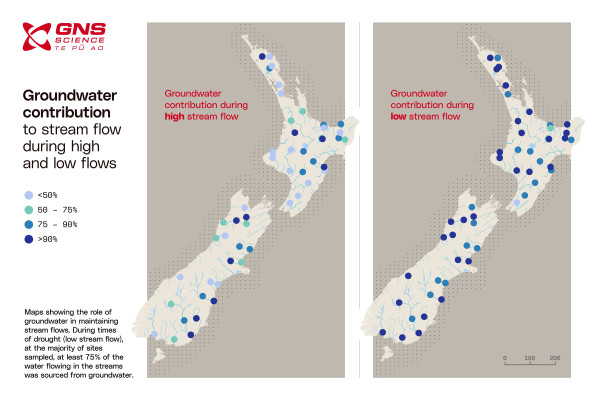Groundwater science rises to the drought challenge

With much of the North Island experiencing drought this summer, and climate change projected to bring drier and hotter conditions, securing Aotearoa New Zealand’s freshwater resilience is vital.
GNS Science is rising to the challenge, building our understanding of Aotearoa’s groundwater systems and striving to provide advanced warning of when and where the impacts of drought will hit in the future.
GNS Science is leading a multi-year research programme to fill in the gaps in our knowledge of the inner workings of our aquifers – their structure and storage, and the rate that water flows through the system and is recharged by rain. The scientists aim to identify the groundwater systems most vulnerable to climate change.
While the most direct cause of drought is lack of rainfall coupled with warm weather, the aquifers beneath our feet play an important role in mitigating the impacts of prolonged drought. During dry spells, some of our rivers and streams cope well when the rain doesn’t come, maintaining water flows, while others suffer low flows. The varying performance can be due to the drought resilience of the groundwater system that replenishes them.
Existing drought assessment tools have a high level of inaccuracy, because they focus on soil and surface water and don’t take into account the deep reservoir of connected groundwater that sustains freshwater systems. The Future-proofing Groundwater Systems research programme will characterise our aquifers’ resilience to drought, identifying those that can buffer drought impacts, and those which are more vulnerable. The models developed by the programme will enable both multi-decade forecasts and seasonal projections of where the impacts of drought will occur.
“These forecasts will help us be better prepared when drought hits, reducing the impacts and costs for our primary producers, regional councils and iwi,” says Catherine Moore, GNS Principal Scientist and Co-Lead of the research programme.

With long-term forecasts New Zealanders can make better decisions about infrastructure projects and land use, mitigating the consequences of reduced water availability.
More than 80% of the water flowing at Aotearoa’s surface is supplied by groundwater, and at times of drought this contribution can be critical. But many of our groundwater catchments are already heavily-allocated, and demand for this vital resource will only increase under climate change.

“Groundwater sustains lives and livelihoods. It recharges our rivers and streams, makes up much of our drinking water supply, and accounts for over 80% of the water used for irrigation. Yet we have very few tools to effectively manage it,” says Moore.
The programme will create models that will allow decision makers to explore the outcomes of a range of land use and water allocation scenarios and support them to develop groundwater management strategies that safeguard our freshwater supply. Models will also help communities to understand the risks and potential consequences of water dependent decisions and manage better during periods of reduced water availability.
Analysing the fingerprint of cosmic rays to understand aquifer storage capacity
Researchers will use an innovative tracer technique to identify where the groundwater has come from and how long it has been underground. One of the tracers used is Tritium, a radioactive isotope of hydrogen produced in the atmosphere by reactions of cosmic rays and atmospheric gases, forming water molecules and travelling down to Earth as part of rainwater. When the rain enters the ground, a “radioactive clock” starts to tick, and the Tritium concentration decreases. This decrease can be measured and the age of the groundwater calculated.
The groundwater age data is used provide information about the storage volumes of the aquifer, along with data from airborne electromagnetic surveying.


The Future-proofing Groundwater Systems programme will also study the resilience of groundwater systems to nitrate contamination and will work alongside those who will bear the brunt of future droughts to map decision pathways that will help them mitigate impacts and adapt to these changes.
-
Partners and funders
- The Future-proofing Groundwater Systems research programme has been awarded $10,407,101 through the Ministry of Business, Innovation and Employment (MBIE) Endeavour Fund.
- The programme will conduct research in five case studies, in regions where drought and nitrate contamination are of greatest concern (Hawke's Bay, Northland, Waikato, Wairarapa and Canterbury).
- Collaborators include Lincoln Agritech, the British Geological Survey, Watermark Numerical Computing (Australia), Intera (USA), Deltares (Netherlands), University of Adelaide (Australia), NIWA, Aqualinc, Land Water People, Scarlatti, Te Herenga Waka – Victoria University of Wellington, and the University of Victoria (Canada).